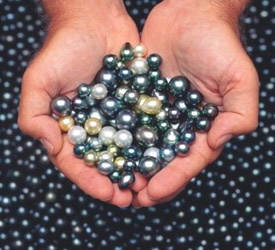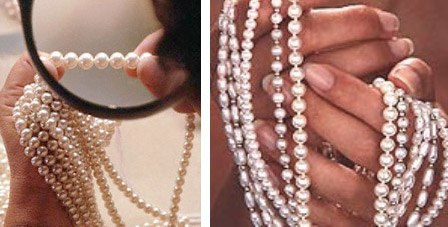|

Pearls are the most valuable gemstones. For already 6 000 years people wear pearl jewelry. As pearls do not need any extra treatment, they shine with natural luster.
If You decided to buy pearls, spend some time on visiting several shops to compare different types, sizes and quality characteristics, learn to make distinctions. Compare the quality of the products offered in stores.

The major pearl quality degrees are luster, thickness and quality of nacre (the upper layer), colour, quality of surface of pearl, shape and size. Pearl quality key determiner is quality and thickness of nacre, whereas nacre thickness defines pearl longevity, whiles the quality – its light-reflecting capacity. High-quality nacre provides pearl’s bright luster and iridescence, conditioned by its thick layer. When determining pearl quality, pay attention to regularity of luster, which reflects light, the occurrence of cracks and chips, as well as the thickness of nacre close to the drilled hole (where the layer of nacre is thinner). Luster has to be intensive. The pearl has to as if shine from within, and not just shimmer in light, which is a sign of imitation. The brightness of luster is determined by light reflected by numerous layers of nacre. Pearls of the highest quality have a sharp contrast between the shiniest part lightened and the darkened parts, which all together create illusion of a sphere inside a pearl. Before making a purchase, be sure to examine the pearl under the fluorescent lamp and roll it in Your palm to control the regularity of luster. The best way to examine pearls is to put them against light grey or white backgrounds, which are perfect to determine pearl quality. By no means use black background!

Equally important is pearl colour. Try the pearls on (put it against Your neck or face) and make sure their colour suits the colour of Your skin and hair. Ask, whether the colour is natural, it is especially concerned with coloured pearls (grey, light blue, black and so on). Pearls of natural color often cost more than white ones, while pearls, coated with paint, cost less. The rarest and finest white pearls have rose shade. Pearls of cream colour (ivory) cost less, as they are more wide spread. The cost of pearls significantly depends also on colour intensity. Thus, pearls of darker shades will cost more, then of lighter ones. It is possible to find pearls of natural shades: white, black, grey, golden, blue, rose and green, but this will need a little elbow grease.

Make sure to examine pearls with a view to blemishes. Though pearl characteristics are best seen against the light background, the occurrence of blemishes is best detected against the dark one, using intensive and diffused illumination. Perfect pearls are extremely rare, so the minor blemishes are acceptable, if the other characteristics (for example, luster or thickness of nacre) are excellent. Pearls with bright luster conceal surface imperfections better.
By no means unimportant is the shape of pearl. There are three major types of pearl shape: symmetrical, spherical and baroque. Spherical pearls are the rarest, which is why they are the most popular. Symmetrical pearls include slightly oblong shapes, as well as pear-shaped pearls, which cost slightly less, comparing to their spherical analogues. Baroque pearls are of irregular shape, which is why they are the cheapest ones.

The size of a pearl is as important as its shape. Large cultured pearls are rare, which is why they cost more. Akoya pearls are the most expensive ones as they reach 7 mm in diameter. The cost of the pearl beasts off with every millimeter, as long as its diameter has reached 8 mm. When shopping for pearls ask for sizes of pearls and compare the differences in cost of similar quality pearls, but of different sizes. The double strand of smaller pearls can produce the same effect as the single strand of larger ones, but it will cost less.
The other important pearl jewelry selection criterion is matching of quality and sizes of pearls in a strand..

When choosing pearls it is important to take into consideration all selection criteria listed above. Graduated pearls need to be carefully selected as well. Pearl matching influences the cost of the jewelry, while badly matching pearls look less attractive and diminish the effect. Make sure to control that all pearls in a strand have the holes drilled strictly on center and they are correctly stringed. Otherwise, the jewelry will have an inaccurate look and diminish its price.
Also, be careful to explore variable characteristics of pearls: fine luster, but the shape is irregular; the shape is regular, but the luster is fainty; luster and colour are excellent, but the surface is imperfect; the shape is excellent, but there is no harmony in the pearl strand. You can learn much about pearl quality from a simple examination.
How to distinguish imitations from natural pearls
The common tests
- Drop the pearl from 30-50 cm in height to a smooth solid surface. Due to its high-density structure the natural pearl will bounce on the surface, like ping-pong ball, while the imitation will hardly bounce once. Make a hole in a sheet of opaque material, which would be slightly less, than the diameter of the examined pearl. Put the pearl against the hole and take the sheet to the source of intensive light (100 W lamp), so that the pearl would be placed between the light and the observer. You will be able to discern a thin glowing bed (up to 2 mm) of nacre and a dark spot of nucleus of the cultured pearl.
- If You put a pearl into a strong electromagnetic field, the natural pearl will stay still, while the cultured will turn and take a certain position (along the field force lines).
- There is a common belief that the cultured pearl fluoresce with green colour in ultraviolet rays, while the natural one - with light blue colour.
- If You examine a hole (if there is one) in a pearl, using 10-fold magnifying glass, You can see the section between the nucleus and the upper layer, which would be in the shape of thin dark stripe – this would be a sign of cultured pearl.
- The holes in cultured pearls are often surrounded by chips (they are softer than the natural ones).
Scientific methods of inquiry:
- Using x-rays: when a correctly taken photo of a cultured pearl is observed, one can usually notice a dividing strip between nucleus and the layer of nacre (in case of unnucleated pearls, there are cavities in a center of a pearl).
- Radioexamination: when a cultured pearl is observed, one can notice a dividing strip between nucleus and the layer of nacre (in case of unnucleated pearls, there are cavities in a center of a pearl).
- Dipping method: pearls are placed into 2, 7 density liquid: the natural pearls would not sink.
- Using a microscope: natural and cultured pearls have rippled surface, while imitations – not.
|
